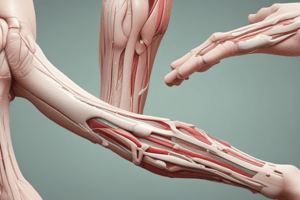Podcast
Questions and Answers
What is the function of the olecranon bursa?
What is the function of the olecranon bursa?
Acts as a cushion between the skin and the olecranon process
What clinical presentation is associated with olecranon bursitis?
What clinical presentation is associated with olecranon bursitis?
Swelling and tenderness of the bursa
How can you suspect epicondylitis or tendonitis in a patient?
How can you suspect epicondylitis or tendonitis in a patient?
Point tenderness at the lateral epicondyle or along the grooves of the olecranon process and epicondyles, increased pain with pronation and supination of the elbow
What is the expected range of motion for elbow flexion and extension?
What is the expected range of motion for elbow flexion and extension?
How can you identify a shoulder dislocation during examination?
How can you identify a shoulder dislocation during examination?
What are the articulations present in the forearm joints?
What are the articulations present in the forearm joints?
What is the term for hyperextension of the metatarsophalangeal joint with flexion of the toe’s proximal joint?
What is the term for hyperextension of the metatarsophalangeal joint with flexion of the toe’s proximal joint?
What deformity is present when there is hyperextension of the metatarsophalangeal joint with flexion of the toe’s proximal and distal joints?
What deformity is present when there is hyperextension of the metatarsophalangeal joint with flexion of the toe’s proximal and distal joints?
Describe the movement permitted by the elbow joint.
Describe the movement permitted by the elbow joint.
What is the term for lateral deviation of the great toe which may cause overlapping with the second toe?
What is the term for lateral deviation of the great toe which may cause overlapping with the second toe?
What type of joint is the elbow?
What type of joint is the elbow?
What is the function of the olecranon bursa in the elbow?
What is the function of the olecranon bursa in the elbow?
What condition is indicated by the formation of a bunion at the pressure point of the great toe?
What condition is indicated by the formation of a bunion at the pressure point of the great toe?
What structures form the arch surrounding and protecting the glenohumeral joint (shoulder)?
What structures form the arch surrounding and protecting the glenohumeral joint (shoulder)?
What signs suggest an inflamed joint that may be caused by conditions like rheumatoid arthritis or gout?
What signs suggest an inflamed joint that may be caused by conditions like rheumatoid arthritis or gout?
What is the purpose of palpating the groove on each side of the olecranon process during an examination?
What is the purpose of palpating the groove on each side of the olecranon process during an examination?
What are Heberden nodes and where are they commonly found?
What are Heberden nodes and where are they commonly found?
What is the normal range of motion for wrist flexion and hyperextension?
What is the normal range of motion for wrist flexion and hyperextension?
What does a carrying angle of 5 to 15 degrees indicate in the arm?
What does a carrying angle of 5 to 15 degrees indicate in the arm?
What can telescoping digits with hypermobile joints indicate?
What can telescoping digits with hypermobile joints indicate?
What are Heberden nodes and where are they located?
What are Heberden nodes and where are they located?
What is indicated by cystic, round, non-tender swellings along tendon sheaths or joint capsules that are more prominent with flexion?
What is indicated by cystic, round, non-tender swellings along tendon sheaths or joint capsules that are more prominent with flexion?
Describe the expected range of motion at the metacarpophalangeal joint when bending the fingers forward.
Describe the expected range of motion at the metacarpophalangeal joint when bending the fingers forward.
What should be the range of hyperextension at the metacarpophalangeal joint when stretching the fingers up and back?
What should be the range of hyperextension at the metacarpophalangeal joint when stretching the fingers up and back?
What should be possible when the patient spreads the fingers apart and then touches them together?
What should be possible when the patient spreads the fingers apart and then touches them together?
What is the expected flexion range of the elbow?
What is the expected flexion range of the elbow?
What is the expected hyperextension range of the elbow?
What is the expected hyperextension range of the elbow?
How do you evaluate wrist muscle strength?
How do you evaluate wrist muscle strength?
How do you test hand strength?
How do you test hand strength?
What may subcutaneous nodules along pressure points of the ulnar surface indicate?
What may subcutaneous nodules along pressure points of the ulnar surface indicate?
What are the subjective and objective data associated with Carpal Tunnel Syndrome?
What are the subjective and objective data associated with Carpal Tunnel Syndrome?
Describe the pathophysiology of Gout.
Describe the pathophysiology of Gout.
What are the common subjective and objective data associated with Osteomyelitis?
What are the common subjective and objective data associated with Osteomyelitis?
Explain the pathophysiology of Bursitis.
Explain the pathophysiology of Bursitis.
What are the key features of Paget Disease of the Bone (Osteitis Deformans)?
What are the key features of Paget Disease of the Bone (Osteitis Deformans)?
Describe the patient data associated with Osteoarthritis.
Describe the patient data associated with Osteoarthritis.
Explain the pathophysiology of Rheumatoid Arthritis.
Explain the pathophysiology of Rheumatoid Arthritis.
What are the subjective and objective data associated with Lumbar Stenosis?
What are the subjective and objective data associated with Lumbar Stenosis?
Describe the patient data related to Temporomandibular Joint Syndrome.
Describe the patient data related to Temporomandibular Joint Syndrome.
What are the characteristics of Abnormalities in the spinal canal?
What are the characteristics of Abnormalities in the spinal canal?
Flashcards are hidden until you start studying




